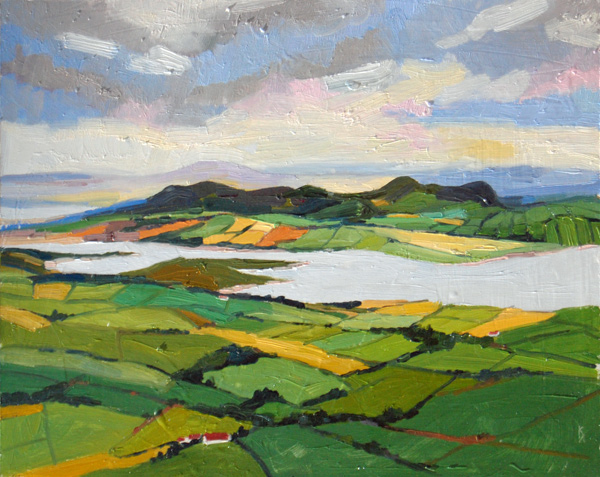|
|
View from Knocknarea

oil on masonite, 16 x 20 inches, 2011
I could spend a year painting every day on Knocknarea. Every view is glorious. The weather and light change from minute to minute creating breathless moments where you scramble to capture the light or color.
A selection from the travel journal Jim wrote in Ireland in July 1999
(While we were traveling by bicycle up the west coast)
That next morning our hostess recommended some interesting places on the other side of Sligo we should see and gave us very clear directions so we could find them. So, after breakfast we set on our merry way to Knocknarea. Knocknarea (the original Irish name means “hill of the queen”) is famed for having a 5000+ year old tomb on its summit called Maeve's Cairn. Maeve was the Bronze Age warrior queen responsible for the war between Connaught and Ulster recounted in Táin Bó Cúailnge (The Cattle Raid of Cooley) — the oldest vernacular epic in western literature. Legend has it that Maeve was buried in the cairn standing and facing her enemies (in actuality, her in-laws!) in the north. However, the cairn was on that mountain long before the Maeve of the Táin was born so the name more likely refers to Maeve the earth goddess, placed on the mountain to watch over her children in the valley below, facing the lords of winter that swept out of the north to harry and kill her children. Regardless of the tomb's actual occupant, we started on a steep but pleasant climb among the sheep to the summit. Every few steps opened amazing vistas over Sligo Town, the bay and the Dartry Mountains beyond. The top of the mountain itself is flat, but dominated by the fifty foot rubble mound of Maeve's Cairn and a number of smaller companion cairns. We scrambled to the top of the cairn and were treated to an amazing view of the whole of County Sligo. We stayed up there for hours painting and drawing, watching the changes of light and weather sweeping across the landscape, and soaking in the atmosphere of this amazing place.
Eventually we followed the trail back to the base of the mountain and went back the way we came, but turning right toward Carrowmore. Carrowmore is a Paleolithic graveyard set in the midst of farmer's fields in the valley below Knocknarea. There are passage tombs, cairns and dolmens here numbering in the hundreds between 7000 and 2500 years old.
The main part of the complex is on land purchased and protected by the government, but many surrounding monuments lie in the fields of local farmers who provide access through goodwill. The first of these we came upon was a wedge tomb just over a stone wall along the road. The farmer had been kind enough to build steps into the wall, so we climbed over to have a look at a smallish dolmen-like structure that the local sheep seemed to enjoy as a place to get out of the weather. We later found out that this tomb was one of the ones that marked the start of the old spiral pilgrimage route through the monuments. A little further up the road was the entrance to the Carrowmore Park itself. A nice little visitorís center has been set up in the cottage of the man who used to own the land. We were just in time for the last guided tour of the day, so we tagged along. The archaeologist leading the tour demonstrated how Maeve's Cairn atop Knocknarea, a companion tomb atop Ben Bulben across the bay, and lesser tombs that looked like nipples atop all of the surrounding mountains of the circular valley likely formed a spiritual protective barrier for the Stone Age inhabitants of the region, as well as serving as boundary markers. The whole area acts as the base of a triangle pointing towards the settlements in the Boyne River valley where one finds the famous (but 700 years more recent) Newgrange.
We trooped around Carrowmore for a while before heading back to our B and B tired but satisfied by the day's experiences.
To purchase this painting, please contact
F.A.N. Gallery, 221 Arch Street, Philadelphia PA 19106
215.922.5155
[detail enlargement]
|

|

|

|
All Images and Text © Kate Kern Mundie 2011 - 2012
|



